Apple II
The Apple II family of computers was the first series of mass-produced microcomputers made by Apple Computer between June 5, 1977 and the mid-1980s
The Apple II had an 8 bit architecture based on the 6502 processor and was the first large scale produced microcomputer to include two original Apple floppy disk drives, and a monitor
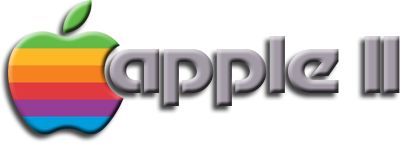
It was designed by Steve Wozniak just like the Apple I, a machine built by hand and sold to hobbyists
It was completely different from Apple's later Macintosh models
It was never produced in large quantities, but it introduced many of the features that would make the Apple II a success
It was popular with home users, and occasionally sold to business people as well
After the launch of VisiCalc, the first computer spreadsheet, sales of the Apple II skyrocketed
Design
Unlike any other microcomputer before it, the Apple II was more like an appliance than an electronic device
It was a computer that would not look out of place at home, in the office or in a classroom
Its lid was easy to remove from the beige plastic casing, allowing access to the inside of the machine, including a motherboard with eight expansion slots, and up to 48 kilobytes of random access memory (RAM)
Apple II had high resolution color and graphics, sound capability, and used the Basic programming language, initially Integer BASIC and later Applesoft BASIC
Compared to previous microcomputers, these features were well documented and easy to learn
Apple II sparked the beginning of the personal computer revolution, since its target market was ordinary people, rather than just engineers or computer enthusiasts
Apple II Family
Apple II original
The first Apple II computers went on sale on June 10, 1977, based on a MOS Technology 6502 microprocessor running at 1 MHz, with 4 KiB of RAM, 12 KiB of ROM with the Integer BASIC programming language, and an interface for audio cassette recorders
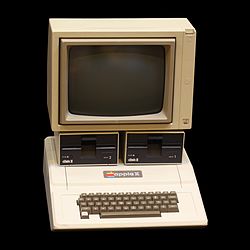
The video controller displayed 24 lines by 40 columns of text in all caps on the screen, with NTSC composite video output for display on a monitor, or on a television set via an RF modulator
Third-party expansion cards were available that displayed 80 columns and supported lowercase letters
Users could save and retrieve programs and data on audio cassettes
Other programming languages, games, applications and other software were also available on cassettes
Original retail price was $1,298 with 4 KiB RAM and $2,638 with 48 KiB RAM
Later, the Disk II, an external 5¼-inch floppy drive, was released along with a controller card that plugged into an expansion slot (usually slot #6) on the computer
This allowed the storage and subsequent recovery of data much more efficiently and quickly
This disk control interface, created by Steve Wozniak, is still considered a marvel of engineering design
The controller card had very little hardware support, with the software providing the necessary encoding
The controller also used a form of GCR (Group Code Recording) coding, which was simpler and easier to implement in software than the more commonly used MFM (Modified Frequency Modulation)
This significantly reduced the total cost, leaving the total system price low enough for home users
It also made it easy for proprietary software development companies to develop forms of protection for their programs, by being able to use tricks such as changing the low level format of the sectors or even moving the drive head between the tracks
However, other groups sold software such as Copy II Plus and Locksmith that allowed those restrictions to be removed
Wozniak's open design and the Apple's multiple expansion slots allowed for a wide variety of third-party devices that expanded the machine's capabilities
Serial port controllers, enhanced video controllers, memory cards, hard drives, and networking components were available for this system in those days
There were also emulator cards, such as the Z80 card, which allowed Apple to use Zilog's Z80 processor and run a multitude of programs developed under the CP/M operating system such as the dBase II database and the WordStar word processor
There was also a 6809 card, manufactured by third parties, with which OS-9 Level One could be run
The Mockingboard sound card greatly improved the Apple's audio capabilities
Even so-called accelerator cards were manufactured, which doubled or quadrupled the speed of the computer
Special mention deserves a family of cards that were actually a PC on a card, some with their own memory, the first using that of the host computer
They used the Apple video and keyboard system as a PC emulation, as well as various cards
They could use the existing disk drives (with the formatting problems if they were not Unidisk), and create a partition on the hard drive from which to run MS-DOS
The processors ranged from Intel 8086 to Intel 80386, with a specific version for the Apple II GS
Apple II Plus
In 1979, the Apple II Plus appeared, which included the Applesoft BASIC programming language in ROM, written by Microsoft, and which was previously available as an upgrade
Applesoft BASIC added support for floating-point arithmetic but sacrificed integer handling speed in the process
The Apple II Plus had between 16 and 48 KB of RAM, expandable to 64 KB via a language card that allowed users to quickly switch between the BASIC dialects "INT" (Integer) and "FP" (Applesoft), but destroyed any unsaved programs in the process
The addition of the language card also allowed the use of the UCSD Pascal and FORTRAN 77 compilers released for the Apple at the time
Apple IIe
In 1982, the Apple IIe was launched, a version that reduced costs and the number of components with newer chips
It also displayed upper and lower case letters on the screen and had 64 KiB of RAM expandable to 128 KiB
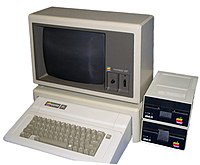
The IIe displayed high resolution text with an 80 column plug-in card
The IIe was probably the most popular Apple II and was widely considered the “workhorse” of the line
Apple IIc
In May 1984, Appel launched its first portable line, the Apple IIc
It used the improved version of the 6502 MOS processor in CMOS technology: 65C02 and offered support for disk controllers, modem, printer, and displayed 80 columns of text that required cards sold separately in previous models
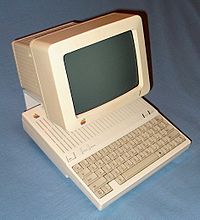
However, due to its compact design, the Apple IIc had limited expandability
Before being marketed, the Apple IIc appeared in various internal documents under the code name “Lolly”
Enhanced Apple IIe
Shortly after launching the Apple IIc, Apple produced the Apple IIe Enhanced which used the 65C02 processor.
The final version of the IIe was known as the Apple IIe Platinum
It added a numeric keypad, internal support for 80 columns, and used a different colored case than previous versions of the IIe.
Apple IIGS
The next and most powerful member of the line was the Apple IIGS computer, released in 1986
The IIGS offered a 2.8 MHz 65C816 processor with 16 bit registers and 24 bit addressing
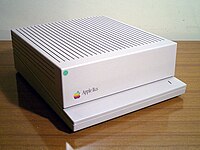
It had more memory, better color, more peripherals (between the IIe-style card slots and IIc-style card controllers), and a graphical user interface derived from the Mac OS
An improved version, IIGS ROM 03, was later introduced in 1989, with more built-in memory and many other improvements
Apple IIc Plus
The Apple IIc Plus, released in 1988, was almost the last Apple II
It was almost the same size as the IIc that came before it, but the 5¼ floppy drive was replaced by a 3½ drive
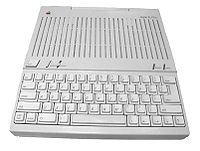
The power supply was placed inside the computer, unlike the IIc in which most of the supply was outside
It had a fast 4 MHz 65C02 processor
This processor made the IIc Plus the fastest Apple II out of the box, although accelerator devices for previous models often exceeded this speed
The IIe and IIc could go, with RocketChip's accelerator, as fast as 10 MHz, while the ZipGS could take the IIGS to 12 MHz or more
Apple IIe Card
In 1990, the Apple IIe Card, an expansion card for the LC line of Macintosh computers, was released
The card was essentially a miniaturized and completely expanded Apple IIe
This allowed the Macintosh to run the Apple II's 8-bit software without any conflicts, thus helping the demise of the Apple II line
Other peripheral cards
During the 1980s, many companies provided the Apple II family with peripheral cards that added functionality thanks to Steve Wozniak's slot design
One of the companies was Applied Engineering
Two of the most popular and successful cards were RamWorks (and its successors RamWorks II and RamWorks III) and TransWarp
The RamWorks III card replaced the auxiliary memory card of the Apple IIe and with the appropriate daughter card could reach 3 MB of RAM memory
The TransWarp card was an accelerator, it could take the speed of the Apple II from its native 1 MHz to 3.6 MHz with the TransWarp and 8 MHz with the TransWarp II
Applied Engineering also developed and sold 1.44 MiB 3½-inch disk drives, an improvement over Apple's original 800 KiB, although Apple later released its own 1.44 MiB drive (dubbed SuperDrive) in the Apple IIe and IIGS
It was one of the last Apple II products released by Apple, and was canceled shortly after, along with the entire Apple II line
Another Apple card was the Apple II ProFile card
This card connected to the Apple ProFile hard drive that was originally designed for the Apple III
It was first available in 5 MB configuration and then in 10 MB storage
End of the Apple II
Around 1986 Apple's Macintosh product line eclipsed sales of the Apple II
Apple continued to sell and support the IIGS until 1992-1993, largely due to its use in schools
However, Apple supported the IIe until 1996, as many video game systems were based on the same chip as the IIe, the most notable being the NES
The Apple IIe made it easier to test game code than with a PC or Mac
Clones
As with the IBM PC, the Apple II was frequently cloned, both in the United States and abroad, with 181 known clones in existence
The Ace series of Apple II clones, manufactured by Franklin Computer Corporation, is the best known and had the most lasting impact, because Franklin copied Apple's ROMs and software and freely admitted it
Franklin's reasoning was that a computer's ROM was simply a pattern of switches set in a certain position, and one cannot copyright a pattern of switches
Apple fought with Franklin for about five years to remove its clones from the market, and was ultimately successful
Later, the company released clones that did not infringe the Apple ROM, but were less compatible with Apple computers
Apple also questioned VTech's Laser 128 computer, an improved clone of the Apple IIc marketed in 1984
This legal challenge ended unsuccessfully for Apple, because VTech had reverse engineered the Monitor ROM instead of copying it, and had licensed the Applesoft BASIC ROM to its creator Microsoft
Incredibly, Apple had neglected to obtain exclusive rights to the Applesoft dialect
The Laser 128 proved popular and remained on the market for many years in its original form and in improved versions that ran faster than 1 MHz
Although it was not fully compatible with the Apple II, it was popular enough that most developers made sure their software worked on the Laser
Because it was frequently sold via mail order and mass merchandise retailers such as Sears, the Laser 128 may have affected low cost competitors such as Commodore Business Machines as much as he did with Apple
While early Apple II clones were generally exact copies of their Apple counterparts, later clones tended to have additional capabilities, in addition to undercutting the price of Apples
An early Franklin model, the Ace 1000, supported a numeric keypad and lowercase letters long before it was added to the Apple IIe
The Laser 128 series is credited with forcing Apple to release the Apple IIc Plus (the 3.5-inch disk drive and accelerated processor were features that the Laser had added)
Marketing, advertising and packaging
Mike Markkula, a retired Intel salesman who provided critical funding for Apple Computer, became interested in its commercialization
From 1977 to 1981, the Regis McKenna agency was in charge of advertising and marketing for Apple
In 1981, Chiat-Day acquired Regis McKenna's advertising operations and then worked for Apple
At the Regis McKenna agency, the team assigned to launch Apple II consisted of Rob Janoff, art director, Chip Schafer, copywriter, and Bill Kelley, account executive
Janoff created the famous bitten apple logo
The design was originally olive green, Steve Jobs insisted on promoting the Apple II's color capabilities by placing rainbow colors
Letterhead and business card the rounded shape of the logo followed the bite in the logo
This logo was developed simultaneously with a commercial and a brochure
Since the original Apple II, Apple paid close attention to packaging quality, in part because of Steve Jobs' personal preferences and opinions on packaging and the final product
The Apple II series packaging was similar, characterized by a large, clean, white space to highlight Apple's rainbow logo
Apple used the Motter Tekkura font until the 1980s when it switched to Apple Garamond
The first advertisement for the Apple II was in the July 1977 issue of Byte magazine, two full pages with the title “Introducing the Apple II” and followed by a third full page that was the purchase form
It was followed by an appearance in the September issue of Scientific American magazine of the same year
Eight television commercials for the Apple IIGS followed, emphasizing the benefits to education and students, along with some print
Near the end of 1982, art director Brent Thomas and Steve Hayden came up with the idea of doing an advertising campaign based on the timely phrase “why 1984 won't be like 1984” in reference to the book titled 1984 by George Orwell
Chiat-Day offered it to several clients, including Apple, and it was proposed to be used in a print advertisement in the Wall Street Journal to promote the Apple II
Apple was not interested and the idea was shelved until the spring of 1983, when they met with the Macintosh marketing team
Peripheral
Storage
The Disk II was a floppy drive for handling 5¼ inch floppy disks
The first DOS for the Apple II were DOS 3.1 and DOS 3.2, which stored 113.75 KiB on each disk
After about two years, DOS 3.3 was introduced
Allowed storage of 140 KiB thanks to a minor change to the disk controller hardware
The user community discontinued use of DOS 3.2 except for running older software
Provided with DOS 3.3 was a program called MUFFIN that allowed users to copy files from DOS 3.2 disks to DOS 3.3 disks
The formatted DOS 3.3 disk had 35 tracks, each track had 16 sectors, and each sector had 256 bytes of data, giving a total of 35 x 16 x 256 = 143,360 bytes (140 KiB)
Tracks 0, 1 and most of 2 were reserved for storing DOS 3.3 itself
Track 17 was reserved for the directory
Track 17 was chosen because it was located in the center of the 35 track disk, thus reducing the average search time for the frequently used directory track
Most game manufacturers did not include DOS 3.3 on their diskettes
They wrote their own boot loaders and read-only file systems to consume the least amount of disk space
Some manufacturers sold floppy disk controllers that could write 40 tracks to most 51/4 inch disks, yielding 160 KiB of storage per disk, but the format did not become popular, and no software is known to have been released in 40 track media
The latest Apple IIs could use the 3½ inch Apple UniDisk 3.5 drive with a total capacity of 800 KiB
DOS 3.3 did not support these drives natively so an upgrade or the use of third-party software was necessary, and disks larger than around 400 KiB had to be split into multiple "virtual disk volumes"
The ProDOS operating system was created in 1983, and was a descendant of the Apple III SOS
It quickly became the Apple II's favorite operating system thanks to native support for volumes up to 32 MB and the fact that the popular AppleWorks application required it
Less common, in the early days, were Apple II computers equipped with an Apple Profile hard drive, which had a total capacity of 5 MB
Later, Apple and other companies introduced IDE and SCSI interface cards along with higher capacity hard drives
A popular model, provided by third parties, was the Sider, from First Class Peripherals, which offered 10 MB for $695, an incredibly low price for the time
Legacy
Nowadays, even a PC that runs on Microsoft Windows An emulator such as AppleWin can emulate major Apple II models by copying the disk over a serial line
However, emulators cannot run software on copy-protected media unless software copy restrictions are removed
Numerous disk images for Apple II software are freely available on the Internet
There is a movement afoot to convince copyright owners of classic Apple II software to officially allow unrestricted free distribution of their software
An unusual tribute to the Apple II is a hack called “bsod” for the XscreenSaver screensaver
The bsod screensaver duplicates the appearance of screens when a computer crashes, for several operating systems, including the “blue screen of death”, from which it takes its name (Blue Screen Of Death)
In the case of the Apple II, the screen saver actually emulates the CRT screen display used at the time, so the screen will appear to twitch as blocks of text flash on and off
Another module, called "Apple2" shows an Apple II at work, beginning to be used to type and run three different BASIC programs, also with CRT emulation, and even with typos or "syntax errors"
Impact on the industry
It is difficult to estimate the enormous impact that the Apple II family had on global business and, especially, the technology industry
Apple II was the first computer that most people had ever seen (on the American continent), and that could be purchased, due to its low cost, by middle class families
Its popularity launched the entire computer games market, the educational software market, explosive growth in the word processor market and the printer market, and the absolute “killer app” for business, VisiCalc, the world's first spreadsheet
By itself, the VisiCalc sold many Apple IIs to many business people
On the other hand, the success in the home market inspired the creation of many other inexpensive personal computers such as the VIC-20 (1980) and the Commodore 64 (1982), that through their significantly low prices introduced computers to several million home users, taking some of Apple's market share in the process
The success of the Apple II spurred IBM to create the IBM PC, which was then purchased by middle managers in all lines of business to run spreadsheet and word processing programs, which at first were simple translations of versions of Apple. the Apple II, and later inspired a whole host of new software application franchises
The strong popularity of these PCs and their clones transformed businesses again, with local networking applications such as email and more recently being used to access USENET and the World Wide Web
A valuable lesson from the first Apple II computers was the importance of an open architecture for a computer platform
The Apple II's expansion slots, by allowing any peripheral card to take control of the bus, sparked an independent industry of card manufacturers that together created a flood of hardware products that gave users the opportunity to build systems that were much more more powerful, useful, and at a lower cost than what would have happened if Apple had kept its system completely proprietary
Apple decided not to create an open architecture with the first models of the Macintosh, and this has widely been seen as hindering its potential success
Meanwhile, IBM created its IBM PC with an open architecture, which spurred it to success
Although in the end its open architecture allowed clones to be manufactured by startup competitors such as Compaq, Dell, Gateway, and countless other manufacturers
Ultimately leading to IBM's abandonment of the personal computer business, selling its PC division in 2005
Trivial
The first version of the video game Where in the World is Carmen Sandiego?, released in 1985 for the Apple II, was included with the purchase of that year's World Almanac
